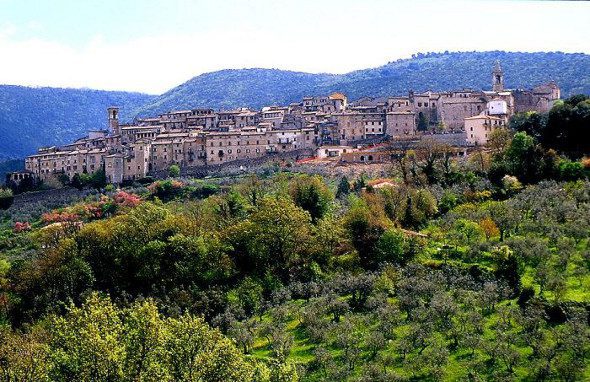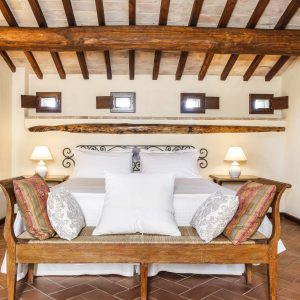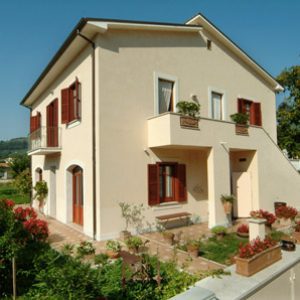▌ Alla scoperta di Stroncone
#BELLAUMBRIA
{“translation”:[{“lang”:”it”,”content”:”
Posto a 450 metri di altezza, Stroncone gode di una posizione incantevole, tanto da essere considerato una eccellente stazione climatica dove trascorrere una tranquilla villeggiatura estiva.
Il primo documento certo su Stroncone risale al 1012. Raso quasi completamente al suolo dalle truppe di Narni dopo un lungo assedio, il paese fu fatto ricostruire nel 1215 agli stessi devastatori per ordine del Papa Innocenzo III.Nel medioevo fu un forte castello, occupato nel 1394 da Pandolfo Malatesta, ma nel 1405 il paese si sollevò cacciando dalle sue mura Andrea Tomacelli che se ne era impadronito. Libero finalmente da ogni sigoria parteggiò per i guelfi, ed accolse tra le sue mura con solenni onori il Papa Pio II, il quale lasciò una lusinghiera descrizione del paese e della sua fertile campagna.Nel 1527 le truppe del Connestabile Borbone, che marciavano su Roma, lo presero d’assedio, ma l’intervento dei Ternani scongiurò il saccheggio. Nel 1799 anche Stroncone insorse contro i Francesi, sostenendo tra l’altro l’assedio dei battaglioni comandati dal generale Jablonowschi.
>>Vuoi vedere Stroncone? Consulta ora le offerte dei migliori agriturismi nelle vicinanze.

>> Ci sono offerte in scadenza per hotel nella zona di Stroncone! Clicca e consultale subito.
Nel 1929 il paese perse la sua autonomia, per riacquistarla nel 1947. Tra i monumenti della cittadina tra i più degni di nota è senzaltro da annoverare il Convento di San Francesco, fondato dal Santo nel 1213. Subito dopo la Porta del Paese, ha il suo ingresso la chiesa di S. Giovanni, decorata da un valente imitatore dello Zuccari. Segue la Chiesa di San Michele Arcangelo, con il bel quadro del Rosario dipinto dall’Agresti. La Chiesa di S. Nicolò conserva invece una bellissima Incoronazione della Vergine di Rinaldo da Calvi, uno dei maggiori allievi dello Spagna. Nella Residenza Municipale sono poi raccolti preziosi documenti dal XIII secolo in po, varie lapidi romane, una notevole collezione di monete e medaglie, e nove coralli membranacei conteneti preziose miniature del ‘400. Le località turistico montane dlle Cimitelle e de I Prati, ad altitudine variabile tra gli 800 e i 1100 m. s.l.m., offrono la possibilità di godere, in ogni momento dell’anno, soggiorni piacevoli, e di raggiungere, attraverso suggestivi sentieri, le cime dei monti circostanti che dominano vasti panorami della Conca Ternana e della Pianura Reatina.
“},{“lang”:”en”,”content”:”Placed at 450 metres above sea level, Stroncone is placed in an enchanting position, and is therefore considered an eccellent climactic resort, where one can spend a tranquil and healthy summer stay.
The first certain document mentioning Stroncone goes back to the year 1012. Nearly completely razed to the ground by troups from Narni after a long siege, the town was rebuilt in 1215 by the same ravagers on the orders of Pope Innocent III. During the Middle Ages it was a strong-hold and was occupied in 1394 by Pandolfo Malatesta, but in 1405 the town rose up and beat back from its town walls Andrea Tomacelli who had taken it over. Finally free of every rule it took the part of the the Guelph party, and welcomed Pope Pius II, who left a very flattering description of the town and of the fertile country-side, with solemn honours into its walls. In 1527 the troups of the Bourbon conestabile, who were marching on Rome, besieged it, but the intervention of the men of Terni prevented the sacking.
In 1799 also Stroncone rose up against the French, and sustained among other things the siege of battaglions under the command of General Jablonowschi. In 1929 the town temporarily lost its autonomy, to reacqist it in 1947. Among the most noteworthy monuments of the city the convent of St. Francis, founded by the Saint in 1213, should be mentioned. Immediately after the Town Portal, the entrance to the church of St. John, decorated by a worthy imitator of the artist Zuccari, is to be found. The Church of the Arcangel St. Michael, with its beautiful picture of the Rosary painted by Agresti follows. The Church of St. Nicholas preserves a beautiful Coronation of the Virgin by Rinaldo of Calvi, one of Spagna’s foremost pupils. In the Town Residence a collection of precious documents of the 8th century onwards, various Roman stones, a noteworthy collection of coins and medals and nine parchment manuscripts containing valuables miniatures dating back to the 15th century, have been collected.
The mountains tourist resorts of the Cimitelle and the Meadows, which are to be found at an altitude between 800 and 1100 meters above sea level, offer the possibility of enjoying a pleasant stay all the year round. Following charming paths, the peaks of the surrounding mountains, which dominate a vast panorama of the Terni basin and the Rieti plain may be reached.
“},{“lang”:”es”,”content”:”Placed at 450 metres above sea level, Stroncone is placed in an enchanting position, and is therefore considered an eccellent climactic resort, where one can spend a tranquil and healthy summer stay.
The first certain document mentioning Stroncone goes back to the year 1012. Nearly completely razed to the ground by troups from Narni after a long siege, the town was rebuilt in 1215 by the same ravagers on the orders of Pope Innocent III. During the Middle Ages it was a strong-hold and was occupied in 1394 by Pandolfo Malatesta, but in 1405 the town rose up and beat back from its town walls Andrea Tomacelli who had taken it over. Finally free of every rule it took the part of the the Guelph party, and welcomed Pope Pius II, who left a very flattering description of the town and of the fertile country-side, with solemn honours into its walls. In 1527 the troups of the Bourbon conestabile, who were marching on Rome, besieged it, but the intervention of the men of Terni prevented the sacking.
In 1799 also Stroncone rose up against the French, and sustained among other things the siege of battaglions under the command of General Jablonowschi. In 1929 the town temporarily lost its autonomy, to reacqist it in 1947. Among the most noteworthy monuments of the city the convent of St. Francis, founded by the Saint in 1213, should be mentioned. Immediately after the Town Portal, the entrance to the church of St. John, decorated by a worthy imitator of the artist Zuccari, is to be found. The Church of the Arcangel St. Michael, with its beautiful picture of the Rosary painted by Agresti follows. The Church of St. Nicholas preserves a beautiful Coronation of the Virgin by Rinaldo of Calvi, one of Spagna’s foremost pupils. In the Town Residence a collection of precious documents of the 8th century o
nwards, various Roman stones, a noteworthy collection of coins and medals and nine parchment manuscripts containing valuables miniatures dating back to the 15th century, have been collected.
The mountains tourist resorts of the Cimitelle and the Meadows, which are to be found at an altitude between 800 and 1100 meters above sea level, offer the possibility of enjoying a pleasant stay all the year round. Following charming paths, the peaks of the surrounding mountains, which dominate a vast panorama of the Terni basin and the Rieti plain may be reached.
“},{“lang”:”de”,”content”:”Placed at 450 metres above sea level, Stroncone is placed in an enchanting position, and is therefore considered an eccellent climactic resort, where one can spend a tranquil and healthy summer stay.
The first certain document mentioning Stroncone goes back to the year 1012. Nearly completely razed to the ground by troups from Narni after a long siege, the town was rebuilt in 1215 by the same ravagers on the orders of Pope Innocent III. During the Middle Ages it was a strong-hold and was occupied in 1394 by Pandolfo Malatesta, but in 1405 the town rose up and beat back from its town walls Andrea Tomacelli who had taken it over. Finally free of every rule it took the part of the the Guelph party, and welcomed Pope Pius II, who left a very flattering description of the town and of the fertile country-side, with solemn honours into its walls. In 1527 the troups of the Bourbon conestabile, who were marching on Rome, besieged it, but the intervention of the men of Terni prevented the sacking.
In 1799 also Stroncone rose up against the French, and sustained among other things the siege of battaglions under the command of General Jablonowschi. In 1929 the town temporarily lost its autonomy, to reacqist it in 1947. Among the most noteworthy monuments of the city the convent of St. Francis, founded by the Saint in 1213, should be mentioned. Immediately after the Town Portal, the entrance to the church of St. John, decorated by a worthy imitator of the artist Zuccari, is to be found. The Church of the Arcangel St. Michael, with its beautiful picture of the Rosary painted by Agresti follows. The Church of St. Nicholas preserves a beautiful Coronation of the Virgin by Rinaldo of Calvi, one of Spagna’s foremost pupils. In the Town Residence a collection of precious documents of the 8th century onwards, various Roman stones, a noteworthy collection of coins and medals and nine parchment manuscripts containing valuables miniatures dating back to the 15th century, have been collected.
The mountains tourist resorts of the Cimitelle and the Meadows, which are to be found at an altitude between 800 and 1100 meters above sea level, offer the possibility of enjoying a pleasant stay all the year round. Following charming paths, the peaks of the surrounding mountains, which dominate a vast panorama of the Terni basin and the Rieti plain may be reached.
“},{“lang”:”fr”,”content”:”Située à 450 mètres d’altitude, Stronconejouit d’une position enchanteresse, tant à être considérée comme une excellente station climatique où passer un séjour estival tranquille.
Le premier document certain sur Stroncone remonte à 1012. Pratiquement rasée complètement au sol par les troupes de Narni après un long siège, le village fût reconstruit en 1215 par les dévastateurs eux-mêmes sur ordre du Pape Innocent III.
Au Moyen-Âge, elle fût un château fort, occupé en 1394 par Pandolfo Malatesta, mais en 1405 le village se souleva en chassant de ses murs Andrea Tomacelli qui en avait pris possession. Finalement libre de toute seigneurie elle prit le partie des Guelphes et accueillit dans ses murs avec tous les honneurs le Pape Pio II, lequel laissa une flatteuse description du village et de sa fertile campagne.
En 1527 les troupes du Conétable Borbone, qui marchaient sur Rome, la prirent d’assaut, mais l’intervention des Ternani empêchérent le saccage. En 1799 Stroncone aussi se souleva contre les Français, en soutenant en outre le siège des bataillons commandés par le général Jablonowschi. En 1929 le village perd son autonomie, pour la reconquir en 1947.
Parmi les monuments de la ville, les plus importants sont sans doute le Couvent de Saint François, fondaé par le Saint en 1213. Tout de suite après la Porte du village on trouve l’entrée de l‘église St. Jean, décorée par un imitateur de talent de Zuccari. Vient ensuite l’église de Saint Michel Archange, avec le beau cadre du Rosaire peint par Agresti. L’église de St. Nicolò conserve en revanche un très beau Couronnement de la Vierge de Rinaldo da Calvi, l’un des plus imporants élèves de Spagna.
Dans la Résidence Municipale sont regroupés de précieux documents du XIIIème siècle et des siècles suivants, diverses pierres romaines, une importante collection de pièces de monnaie et de médailles, et neufs coraux contenant de précieuses miniatures du XVème siècle.
Les localités touristiques montagneuses de Cimitelle et de I Prati, à une altitude variant de 800 à 1100 au-dessus du niveau de la mer, offrent la possibilité de profiter, à tout moment de l’année, de séjours plaisants et permettant de rejoindre, à travers des sentiers suggestifs, les cimes des monts alentours qui dominent les vastes panoramas de la Conque de Terni et de la Plaine de Rieti.
“}]}







